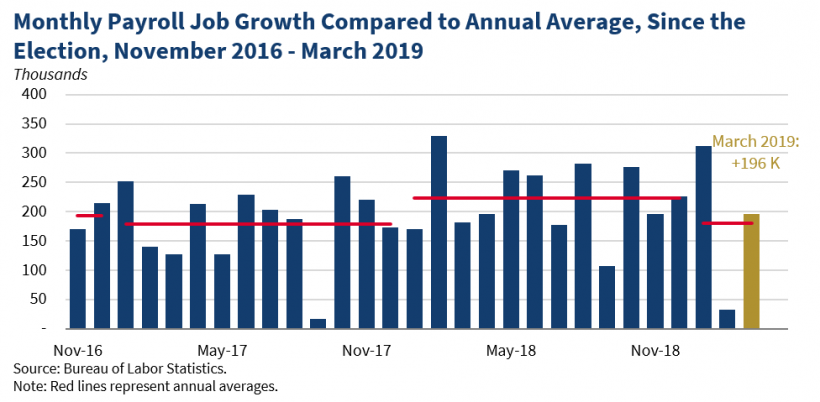The Bureau of Labor Statistics (BLS) released its monthly Employment Situation Report, showing that the United States economy is continuing to boom with a strong labor market. Total nonfarm payroll employment in March rose by 196,000 jobs (see figure), beating market expectations (175,000). The month of March continued the longest streak of growth on record (102 months). Job gains in February were revised up by 13,000, and January jobs were revised up by 1,000 for a cumulative increase of 14,000 jobs. In total, the economy has added over 5.5 million jobs since President Donald J. Trump was elected.

The March jobs report reflects a sharp rebound in job growth, suggesting that February’s revised outcome (+33K) was a blip rather than a trend. Since the President was elected, job gains have surpassed 100,000 jobs in 26 of the 28 months. The average jobs growth in the past 12 months is a robust 211,000 jobs and jobs growth in the past 6 months has averaged 207,000 jobs. Both the 12-month and 6-month averages remain above the 2017 average of 179,000 jobs gained per month.
Job growth in March was largest in the education and health services industry, which added 70,000 jobs. Since the President’s election, the manufacturing industry has added 480,000 jobs and 209,000 jobs in the past 12 months.
The report indicates that strong jobs growth is being coupled with wage growth. Nominal average hourly earnings rose by 3.2 percent over the past 12 months, marking the 8th straight month that that year-over-year wage gains were at or above 3 percent. Prior to 2018, nominal average hourly wage gains had not reached 3 percent since April 2009. Taking inflation into account, there is evidence that real wages are also growing. Based on the most recent Personal Consumption Expenditures (PCE) price index data from January, inflation in the past year was 1.4 percent, and based on the most recent Consumer Price Index (CPI-U) price data from February, the inflation in the past year was 1.5 percent. (March inflation data is not yet available for either series).
A separate household survey released by BLS shows that the unemployment rate remained steady at 3.8 percent in March—and marks the 13th consecutive month at or below 4 percent. The unemployment rate for adult women (20+) ticked down to 3.3 percent and re-achieved its lowest rate since 1953.
The labor force participation rate – which tracks how many people are working or looking for work—edged down by 0.2 percentage point to 63 percent, but 0.3 percentage point above the rate when the President was elected in November 2016. The labor force participation rate for prime-age adults (ages 25-54) which largely avoids the demographic effects of the aging population held steady at 82.5 percent—1.1 percentage points above the rate at the President’s election in November 2016.
A thriving economy stimulated by pro-worker policies is pulling workers off the sidelines. In spite of the continued low unemployment rates over the past year, there is still what economists call “labor slack”—or a pool of potential workers on the sidelines. This allows for continued employment and overall economic growth as workers reenter the labor force. In the first quarter of 2019, 71.4 percent of workers entering employment came from out of the labor force rather than from unemployment.
The March employment data depict an American economy that remains strong and booming with a continued low unemployment rate, historic trends in job growth, and rising wages.
